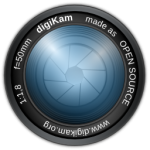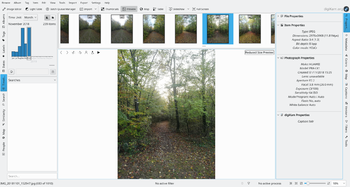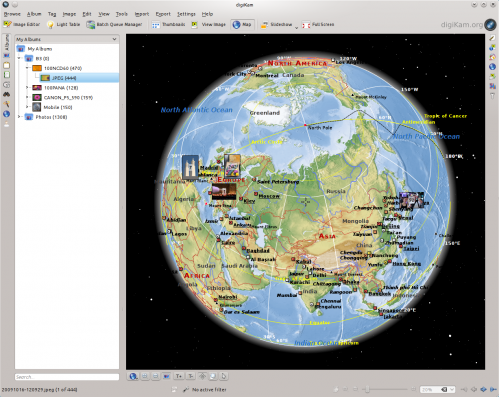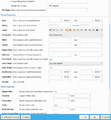Digikam
 |
Ver, administrar, editar, mejorar, organizar, etiquetar y compartir fotos. |
DigiKam permite la importación de fotografías desde cámaras, creación de álbumes, etiquetado con fechas, temas y otras propiedades, y utilidades de búsqueda excelentes. Por favor, consulta el manual para ver todos los detalles, incluyendo los formatos de imágenes compatibles.
Features
Administración de fotografías
-
Vista del álbum
-
Línea de tiempo
-
Viendo información Exif
-
Geolocalización
-
Búsquedas
-
Búsquedas detalladas
-
Identificación de duplicados
-
Búsqueda difusa
Digikam provides advanced functionality to manage your photos. You can view your photos in chronological order, or classify the photos in different albums, there is also the possibility to organize your photos with the localization they were taken.
-
Create Album
-
Timeline View
-
Map View
Moreover, Digikam also provide multiple search features, you can do a simple keyword search, but also advanced search on the metadata and even some fuzzy search, where you draw a pattern and Digikam try to find matching photos. Digikam can also found duplicate in your library.
-
Simple Search View
-
Detailed Search
-
Fuzzy Search
-
Identify duplicates
Digikam can also display the Exif information of your photo.

El editor de imágenes
-
Etiquetas
-
Asignación de puntuaciones
-
Ajuste de los niveles de color
-
Ajuste de balance de blancos
-
Convertir a blanco y negro
-
Corrección de ojos rojos
-
Corrección de color automática
-
Corrección de lente automática
La interfaz para cámaras
-
Lectura de medios extraíbles
-
o desde una cámara
-
Guardado directo a los álbumes
-
Añade geolocalización a fotos individuales
La mesa de luz
-
Comparar una serie de fotografías
-
Examinar detalles
-
Las puntuaciones hacen que elegir sea más fácil
-
Ver la configuración de la cámara
ShowFoto
Para aquellos que encuentren la interfaz de DigiKam demasiado técnica, ShowFoto da acceso a las misas herramientas, con una interfaz popular.
-
Navegación
-
Propiedades de la imagen
-
Ver propiedades de la imagen
-
Geolocalización de nuevo
-
Ampliaciones predefinidas
-
Histograma
-
Preferencias generales
-
Opciones de ayuda de herramientas
-
Opciones para imágenes Raw
-
Preferencias de gestión del color
-
Opciones de guardado de archivos
-
Configuración de una presentación
La página de ayuda del proyecto tiene enlaces a Preguntas más frecuentes (FAQs) y a los detalles para la suscripción a Listas de correo.
La sección sobre Gestión de recursos digitales ya no está disponible en las páginas web, aunque si lo está en el manual, que puede aparecer en tu distribución como digikam-doc, o que puedes descargar como un conjunto de archivos .pdf, digikam.pdf, showfoto.pdf and kipi-plugins.pdf
El blog Open Source Photo Processing Comes of Age de rm42 analiza el desarrollo desde la versión de KDE 3, y proporciona una visita guiada útil.
Tenemos una colección creciente de tutoriales que te ayudará a disfrutar más y a tener más productividad con digikam. La página de tutoriales de Digikam tiene un lista con un breve comentario sobre el contenido.
Useful digiKam Tricks
Transcribed from Dmitri Popov's blog, 26 September 2011
- To quickly adjust thumbnail size in the Album view, press and hold the Ctrl key, then use the mouse scroll wheel to make the thumbnails larger or smaller.
- With the feature enabled, digiKam automatically hides originals and displays the latest modified versions of the photos. For example, if you process a NEF file and save it in the JPEG format, digiKam hides the original RAW file and shows only the JPEG photo. To disable this feature, choose and make sure that the option in the In main view section is enabled. To keep things tidy, you can then group the original and all its versions. To do this, select the photos you want to group, right-click on the selection, and choose .
The trash has reached its maximum size! Cleanup the trash manually
If you receive this error message and emptying the Trash doesn’t help, then the following command may solve the problem:rm ~/.local/share/Trash/metadata
- Need to quickly locate all untagged photos? In digiKam, expand the left sidebar, and press the button. In the window, tick the check box and press to run the search.
- Instead of the conventional thumbnail view, digiKam lets you map your photos on a globe. Choose , and you should see photos from the current album mapped on the 3-D globe. You can then use the mouse to rotate the globe and the mouse wheel to zoom in and out. Obviously, the Map view displays only geotagged photos.

Download
Digikam is available for Linux, Windows and MacOS. For Linux, you can find Digikam in your distribution repository or you can also download Digikam as an AppImage.
For Windows and MacOS, you can download Digikam binary on the digiKam website download page.
Beta version and source code are also available on the digiKam website download page.
Tutorials
There is a lot of tutorials about using Digikam. These tutorials are taken from Dmitri Popov and Mohamed Malik blogs about using Digikam, and have given us permission to reproduce them.





































